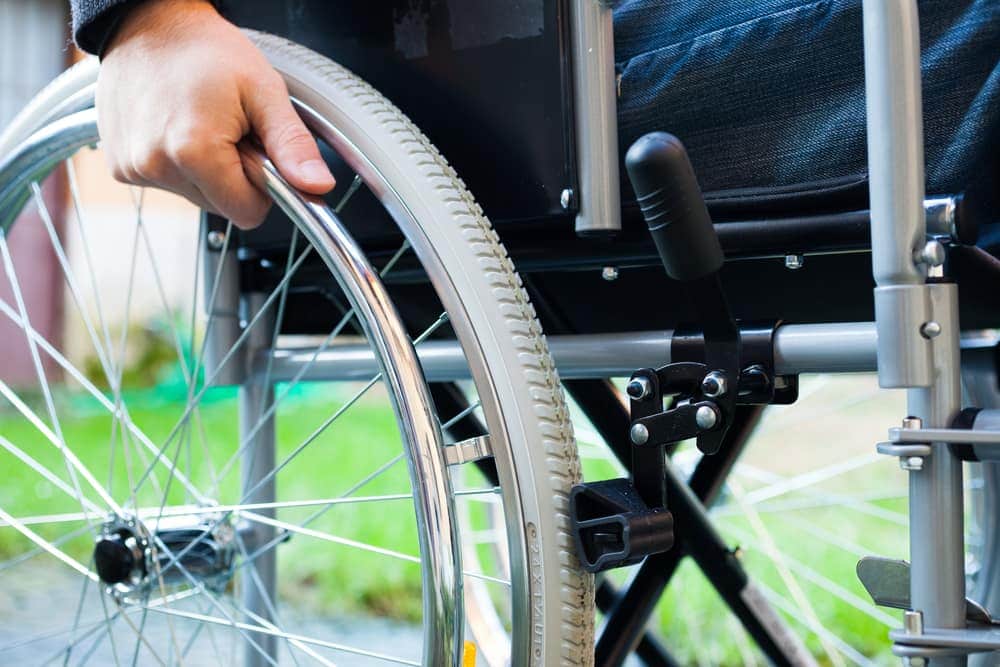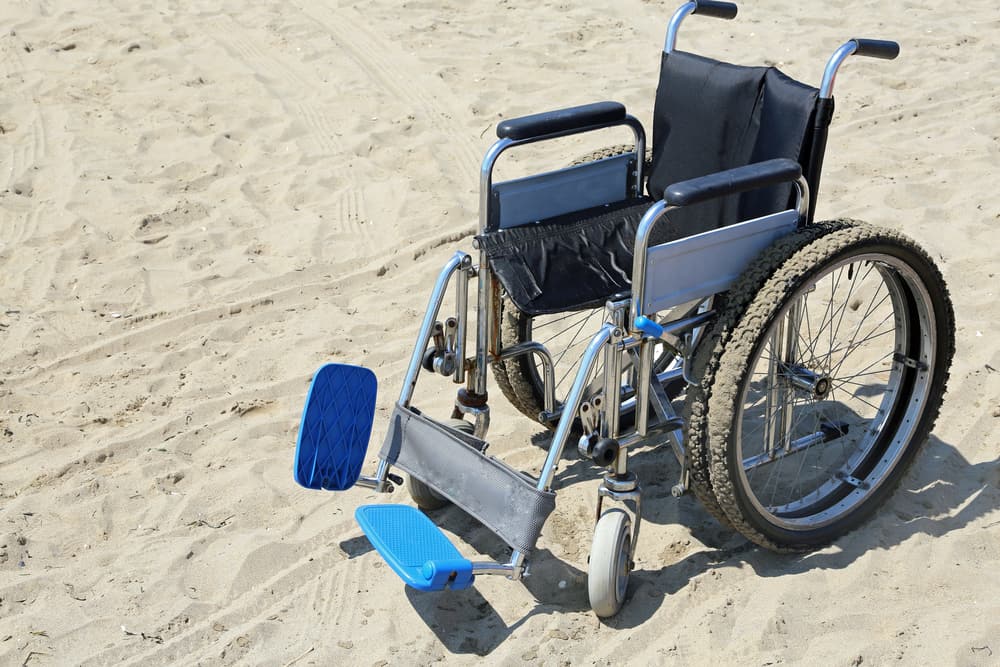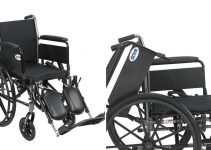Wheels are an important part of wheelchairs. However, most people do not know if the wheels are good or not when buying a new wheelchair or replacing wheels.

In this post, we will guide you on how to choose the right wheelchair wheels and explain all the facts and details in a simple way.
Components of A Wheelchair Wheel
A wheelchair wheel consists of a tire, rim, handrim, spokes (mags), and a hub.
In general, we call the wheels in the front “front wheels,” “casters,” or “steering wheels,” and the wheels in the back are called “rear wheels” or “drive wheels.”
Most wheelchairs come with a pair of steering wheels and a pair of drive wheels. But some power wheelchairs have 3 pairs of wheels with a pair of drive wheels included. Regarding the transport chairs, as caregivers push them, they often come with 2 pairs of wheels of the same size.
Note that a wheelchair can only accommodate some specific wheels so that you should check the specifications before making a purchase.
Types of Wheelchair Wheel Tires
We can divide all the wheelchair wheel tires into two categories: pneumatic tires and flat-free tires. There are also some subcategories in flat-free tires. Each type of tire has its own pros and cons, and we will explain them below.
Pneumatic tires

Pneumatic tires are the commonly used type of wheelchair wheel tires. It is made out of rubber with an air-filled inner tube. Compared to flat-free tyres, pneumatic tyres come with a lower price tag.
It is better for outdoor use given that it features a shock-absorbing function, so you will feel comfortable and stable while going through uneven terrains. They are also lighter, making the propulsion easier.
However, pneumatic tires are susceptible to sharp objects and will lose air over time. This means that the tires may go flat on the way, so it is better to prepare some replacement.
Luckily, it is not too complicated to get the replacement done. You can do it on your own or go to a bike shop.
Flat-free tires
Solid tires

Usually, the solid tires are made with rubber with foam, urethane, or latex insert. They are heavier but hard to be punctured. But if you have to replace it, it will be costly, and you should ask some experts to do that for you.
Solid tires are stiffer than the pneumatic ones, and the traction is not good enough for bumpy roads and slippery slopes. Therefore, we recommend using it indoors and on even surfaces out of the house.
Pneumatic tires filled with a semi-solid material
This is a relatively new type of wheelchair wheel tire. It combines the advantages of pneumatic tires and solid tires to some extent.
As it is filled with semi-solid material, it will not be as heavy as the traditional solid tires. Meanwhile, it has a certain shock absorption capacity, improving its performance on uneven surfaces. Even better, it is still flat-free.
You can opt for it if you want a chair that can handle both indoor surfaces and outdoor surfaces well.
Types of Wheelchair Wheel Spokes
You always come across descriptions like this “we use mag-style wheels” on the product page, but what is “mag-style wheel” exactly?


The spokes of a mag-style wheel are often less than ten, and they are made of composite materials. Spoke wheels often appear on cheaper manual wheelchairs, and they are less efficient than spoke wheels.
For a spoke-style wheel, the number of spokes can be as much as 36. Generally speaking, a spoke wheel is lighter and will not become deformed easily. Plus, it has a better shock absorption capacity. However, it may require more maintenance.
Types of Wheelchair Wheel Treads

Wheelchair wheel tread is aiming to improve the traction to the ground. The smoother tread offers less resistance, making it easier for you to push the wheelchair. However, it could be dangerous when using it on too slippery surfaces. Therefore, it is better for indoor use.
If you plan to spend more time outdoors, you should opt for wheels with a wider and more knobby tread. In this way, your wheelchair is able to go through uneven terrains.
Truing The Wheelchair Wheels

Truing your wheelchair wheels at times can add more safety and improve propelling efficiency.
Make sure the camber ( refers to the tilting of the wheel inward or outward in its vertical plane) is rightly adjusted so that your hands can propel the chair comfortably and efficiently.
Aside from that, it is also important to ensure the wheel on each side is parallel. Off-parallel wheelchair wheels may lead to unstable rides and tears, and wear on the tires.
Choosing The Wheels According To The Type of Wheelchairs and Your Needs
There are a few types of wheelchairs on the market.
If you are using a motorized wheelchair, the wheels are not as large as the wheels of manual wheelchairs. But the tires are thicker, and the treads are knobby for the chair to maneuver on rough roads.
For manual wheelchair users, you should think about how you will use the chair. That said, it is common to buy a few different pairs of wheels to cater to your different needs.
If you intend to use it more indoor, then a mag-style wheel with light treads and solid tires could save you a certain effort.
However, a spoke-style wheel with heavy treads and pneumatic tires will bring you a more stable and comfortable ride for those who will spend hours outdoors.
The typical wheel sizes of manual wheelchairs are 22″, 24″, and 26″. Even though larger wheels may offer better maneuverability, you should also check if you can reach the handrim easily without arching your shoulder or bending forward.
Transport chairs often come with small casters with solid or pneumatic tires. While small casters can offer agility, but they can’t handle bumpy roads well. So get one with bigger rear wheels and front wheels with pneumatic tires for outdoor use even though it may need more maintenance.
Conclusion
You should take a few factors into account when choosing wheelchair wheels. Tires, spokes, treads, rim, and handrim all play a role in affecting your ride.
For indoor use, try to select components that cause less resistance, but it is better to get a pair of wheels that has better traction to the ground for outdoor use.



